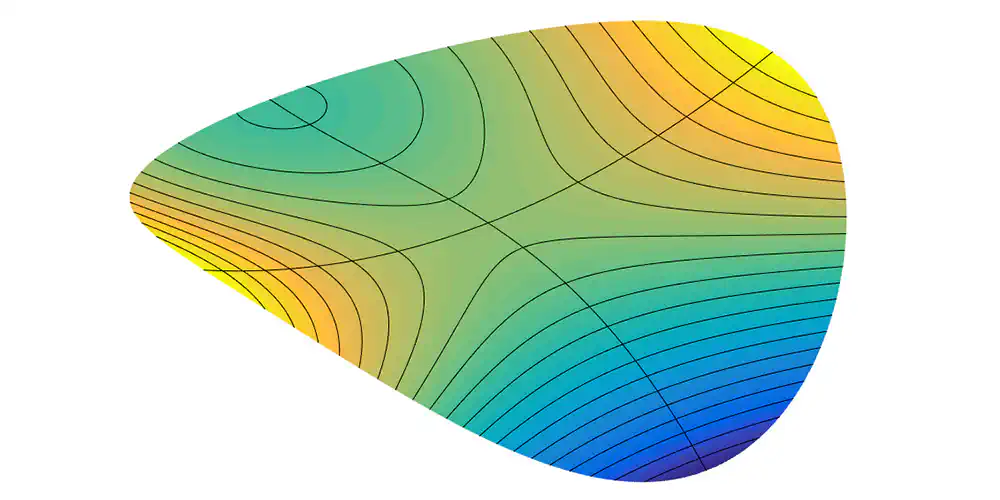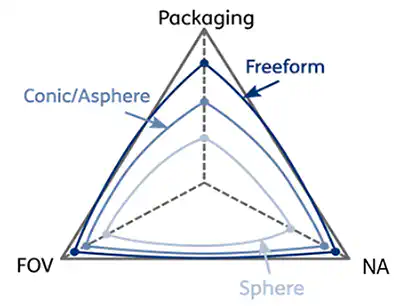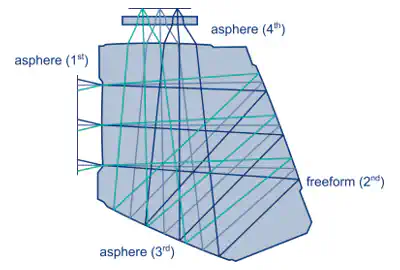
Freeform optics: Fields of application and future opportunities for use
Potentials and challenges of freeform optics
Content
As already explained within the article “Spheres vs. Aspheres”, the use of aspheres in optical systems allows, among other things, more compact designs because the number of lenses used can be reduced if necessary. If a system needs to be further reduced in size without loss of performance, the beam path can be folded, for example. To compensate for resulting (asymmetric) aberrations, freeform optics are used. They must be comparable to spherical and aspheric elements in terms of their properties, otherwise no consistent quality can be guaranteed. High quality of freeform optics is therefore a mandatory requirement for their use.
A comparison of freeforms with spheres and aspheres regarding numerical aperture, field of view and miniaturization is shown in the following figure. Freeform optics can achieve improvements for all three parameters mentioned.
Figure 1: Comparison between sphere, asphere and freeform in terms of field of view (FOV), numerical aperture (NA) and miniaturization.
Thanks to their special surface shape, they can also fulfil functions that cannot be achieved with classic optics. Especially for small optical components, such as monoliths, this is particularly advantageous when folding the optical beam path and can replace existing arrangements, such as mirror systems. Another great benefit of monolithic freeform optics (see e.g. Fig. 2) is the saving of time-consuming alignment and adjustment work.
Figure 2: Optical design of a monolithic system consisting of three aspheric and one freeform surface with simulated beam path folding. Created within the growth core fo+.
Definition of freeform optics
Considering the geometrical aspect, a freeform can be defined as an optic whose surface has no rotational symmetry or translation around the optical axis. The mathematical characterization of the freeform surface is very complex and demanding. Compared to spherical or aspheric surfaces, a freeform surface has significantly more degrees of freedom. By breaking up the symmetry, optical designers have new possibilities for creating designs. Of course, this makes the geometry of the optical component more complex and it is necessary to use reference structures for orientation.
There are several possibilities for the mathematical description of freeform optics. asphericon works with Zernike-Fringe polynomials according to ISO 10110, where the surface profile (sag) is described mathematically by
Where c is the reciprocal of the radius of curvature, k is the conic constant, Zi is the standard Zernike polynomial and Ai the Zernike coefficient, r is the radial coordinate of the surface, ρ (rho) the normalized radial and φ (phi) the angular coordinate.
Another possibility is the mathematical calculation using the XY polynomial, which is described by the following equation:
Here Cj stands for the coefficient of the polynomial and the radial coordinate r is calculated by:
m and n are the exponents of the x,y polynomials.
Applications
The great potential of freeform optics has already been discovered by various industries. In the automotive industry, driver assistance systems increasingly enhance the driving experience. To improve these assistance systems, more and more sensor systems are being installed in vehicles. To be able to build them in their complexity, it is important that each individual system takes up as little installation space as possible. This is where freeform optics come into play. In newer car models, freeforms can be found in various implementations, e.g. within Head-up displays. Freeform optics are also used in the imaging/display industry, for example in projection systems.
Future ideas for the use of freeforms
In principle, freeform optics can be used wherever folding of the optical beam path is required, oblique incident light has to be focused and/or a miniaturization of the system is desired. The reduction of mass and volume in combination with the largest possible field of view makes freeform systems interesting for a wide range of applications in the future. The aerospace industry, for example, could develop into an exciting field of application.
Furthermore, their great potential can be used in the field of safety applications, e.g. in camera systems for firefighter helmets. Currently, firefighters have to hold infrared cameras in their hands to find people in burning or collapsed buildings. Consequently, they only have one hand to clear obstacles and help victims. In the future, the hand-held infrared camera could be replaced by a freeform infrared system built into the helmet. Combined with AR glasses, thermal images can be made visible immediately.
An example of the use of freeforms in a thermography system can also be found in the project description of the research project “Freeform Optics Plus (fo+)”.
Challenges of freeform optics
Optical freeform surfaces have numerous geometrical degrees of freedom, so many parameters challenge design and production. Due to their special properties, freeform optics potentially allow
- More compact designs,
- Miniaturization of optical systems and
- Very good optical performance, which is in no way inferior to classical elements.
However, their characterization is complex and time-consuming. New software and compatible production processes are required to handle the large amounts of data generated by the development and manufacturing process. In the age of Industry 4.0, however, new possibilities are opening up all the time, so above all production can become easier. Due to the many possible applications and the new markets opening in the field of optics, freeform optics will play an increasingly important role in the future.


